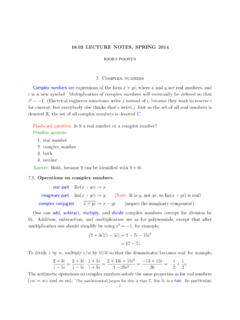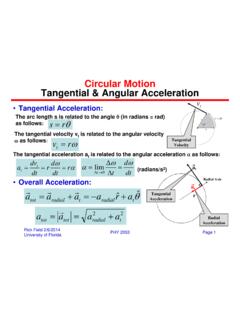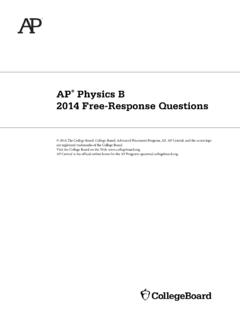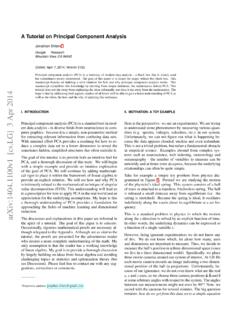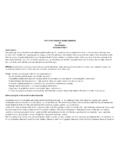Transcription of Reading 7a: Joint Distributions, Independence
1 Joint Distributions, IndependenceClass 7, Orloff and Jonathan Bloom1 Learning Goals1. Understand what is meant by ajointpmf, pdf and cdf of two random Be able to compute probabilities and marginals from a Joint pmf or Be able to test whether two random variables are IntroductionIn science and in real life, we are often interested in two (or more) random variables at thesame time. For example, we might measure the height and weight of giraffes, or the IQand birthweight of children, or the frequency of exercise and the rate of heart disease inadults, or the level of air pollution and rate of respiratory illness in cities, or the number ofFacebook friends and the age of Facebook :What relationship would you expect in each of the five examples above?
2 Why?In such situations the random variables have ajoint distributionthat allows us to computeprobabilities of events involving both variables and understand the relationship between thevariables. This is simplest when the variables areindependent. When they are not, we usecovarianceandcorrelationas measures of the nature of the dependence between Joint Discrete caseSupposeXandYare two discrete random variables and thatXtakes values{x1, x2, .. , xn}andYtakes values{y1, y2, .. , ym}. The ordered pair (X, Y) take values in the product{(x1, y1),(x1, y2), ..(xn, ym)}.
3 Thejoint probability mass function( Joint pmf) ofXandYis the functionp(xi, yj) giving the probability of the Joint outcomeX=xi, Y= organize this in ajoint probability tableas class 7, Joint Distributions, Independence , spring 20142X\ (x1, y1)p(x1, y2) p(x1, yj) p(x1, ym)x2p(x2, y1)p(x2, y2) p(x2, yj) p(x2, ym) xip(xi, y1)p(xi, y2) p(xi, yj) p(xi, ym) xnp(xn, y1)p(xn, y2) p(xn, yj) p(xn, ym)Example two dice. LetXbe the value on the first die and letYbe the value onthe second die.
4 Then bothXandYtake values 1 to 6 and the Joint pmf isp(i, j) = 1/36for alliandjbetween 1 and 6. Here is the Joint probability table:X\Y1 2 3 4 5 61 1/36 1/36 1/36 1/36 1/36 1/362 1/36 1/36 1/36 1/36 1/36 1/363 1/36 1/36 1/36 1/36 1/36 1/364 1/36 1/36 1/36 1/36 1/36 1/365 1/36 1/36 1/36 1/36 1/36 1/366 1/36 1/36 1/36 1/36 1/36 1/36 Example two dice. LetXbe the value on the first die and letTbe the total onboth dice. Here is the Joint probability table:X\T2 3 4 5 6 7 8 9 10 11 121 1/36 1/36 1/36 1/36 1/36 1/36 0 0 0 0 02 0 1/36 1/36 1/36 1/36 1/36 1/36 0 0 0 03 0 0 1/36 1/36 1/36 1/36 1/36 1/36 0 0 04 0 0 0 1/36 1/36 1/36 1/36 1/36 1/36 0 05 0 0 0 0 1/36 1/36 1/36 1/36 1/36 1/36 06 0 0 0 0 0 1/36 1/36 1/36 1/36 1/36 1/36A Joint probability mass function must satisfy two properties:1.
5 0 p(xi, yj) 12. The total probability is 1. We can express this as adouble sum: n mi=1 p(xi, yj) = 1j= class 7, Joint Distributions, Independence , spring Continuous caseThe continuous case is essentially the same as the discrete case: we just replace discrete setsof values by continuous intervals, the Joint probability mass function by ajoint probabilitydensity function, and the sums by values in [a, b] andYtakes values in [c, d] then the pair (X, Y) takes values inthe product [a, b] [c, d]. Thejoint probability density function( Joint pdf) ofXandYis a functionf(x, y) giving the probability density at (x, y).
6 That is, the probability that(X, Y) is in a small rectangle of widthdxand heightdyaround (x, y) isf(x, y)dx =f(x, y)dx dydydxcxabA Joint probability density function must satisfy two properties:1. 0 f(x, y)2. The total probability is 1. We now express this as adouble integral: d bf(x, y)dx dy= 1caNote: as with the pdf of a single random variable, the Joint pdff(x, y) can take valuesgreater than 1; it is a probability density,nota we won t expect you to be experts at double integration. Here s what we willexpect. You should understand double integrals conceptually as double sums.
7 You should be able to compute double integrals over rectangles. For a non-rectangular region, whenf(x, y) =cis constant, you should know that thedouble integral is the same as thec (the area of the region). EventsRandom variables are useful for describing events. Recall that an event is a set of outcomesand that random variables assign numbers to outcomes. For example, the event X >1 is the set of all outcomes for whichXis greater than 1. These concepts readily extend topairs of random variables and Joint class 7, Joint Distributions, Independence , spring 20144 Example Example 1, describe the eventB= Y X 2 and find its :We can describeBas a set of (X, Y) pairs:B={(1,3),(1,4),(1,5),(1,6),(2,4),( 2,5),(2,6),(3,5),(3,6),(4,6)}.
8 We can also describe it visuallyX\Y1 2 3 4 5 61 1/36 1/36 1/36 1/36 1/36 1/362 1/36 1/36 1/36 1/36 1/36 1/363 1/36 1/36 1/36 1/36 1/36 1/364 1/36 1/36 1/36 1/36 1/36 1/365 1/36 1/36 1/36 1/36 1/36 1/366 1/36 1/36 1/36 1/36 1/36 1/36 The eventBconsists of the outcomes in the shaded probability ofBis the sum of the probabilities in the orange shaded squares, soP(B) = 10 take values in [0,1] with uniform densityf(x, y) = the event X > Y and find its :JointlyXandYtake values in the unit square.
9 The event X > Y correspondsto the shaded lower-right triangle below. Since the density is constant, the probability isjust the fraction of the total area taken up by the event. In this case, it is clearly X > Y x1 The event X > Y in the unit take values in [0,1] with densityf(x, y) = 4xy. Showf(x, y) is a valid Joint pdf, visualize the eventA= X < andY > and find :JointlyXandYtake values in the unit class 7, Joint Distributions, Independence , spring 20145y1Ax1 The eventAin the unit showf(x, y) is a valid Joint pdf we must check that it is positive (which it clearly is)and that the total probability is 1111 Total probability = 4xy dx dy=2x2y dy=2y dy= 0 0[ 0 The eventAis just the upper-left-hand quadrant.]
10 Because]the density is not constant wemust compute an integral to find the (A) = .5 dy dx= [2xy2]= 02dx= Joint cumulative distribution functionSupposeXandYare jointly-distributed random variables. We will use the notation X x, Y y to mean the event X xandY y . Thejoint cumulative distribution function( Joint cdf) is defined asF(x, y) =P(X x, Y y)Continuous case:IfXandYare continuous random variables with Joint densityf(x, y)over the range [a, b] [c, d] then the Joint cdf is given by the double integralF(x, y) = y xf(u, v)du recover the Joint pdf, we differentiate the Joint cdf.










